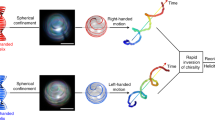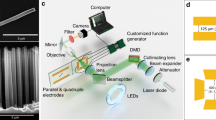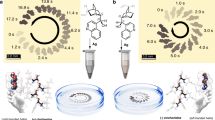Abstract
Molecular machines operated by light have been recently shown to be able to produce oriented motion at the molecular scale1,2 as well as do macroscopic work when embedded in supramolecular structures3,4,5. However, any supramolecular movement irremediably ceases as soon as the concentration of the interconverting molecular motors or switches reaches a photo-stationary state6,7. To circumvent this limitation, researchers have typically relied on establishing oscillating illumination conditions—either by modulating the source intensity8,9 or by using bespoke illumination arrangements10,11,12,13. In contrast, here we report a supramolecular system in which the emergence of oscillating patterns is encoded at the molecular level. Our system comprises chiral liquid crystal structures that revolve continuously when illuminated, under the action of embedded light-driven molecular motors. The rotation at the supramolecular level is sustained by the diffusion of the motors away from a localized illumination area. Above a critical irradiation power, we observe a spontaneous symmetry breaking that dictates the directionality of the supramolecular rotation. The interplay between the twist of the supramolecular structure and the diffusion14 of the chiral molecular motors creates continuous, regular and unidirectional rotation of the liquid crystal structure under non-equilibrium conditions.
This is a preview of subscription content, access via your institution
Access options
Access Nature and 54 other Nature Portfolio journals
Get Nature+, our best-value online-access subscription
$29.99 / 30 days
cancel any time
Subscribe to this journal
Receive 12 print issues and online access
$259.00 per year
only $21.58 per issue
Buy this article
- Purchase on Springer Link
- Instant access to full article PDF
Prices may be subject to local taxes which are calculated during checkout





Similar content being viewed by others
References
Balzani, V., Credi, A. & Venturi, M. Light powered molecular machines. Chem. Soc. Rev. 38, 1542–1550 (2009).
Kassem, S. et al. Artificial molecular motors. Chem. Soc. Rev. 46, 2592–2621 (2017).
Browne, W. R. & Feringa, B. L . Making molecular machines work. Nat. Nanotech. 1, 25–35 (2006).
Chen, J. et al. Artificial muscle-like function from hierarchical supramolecular assembly of photoresponsive molecular motors. Nat. Chem. https://doi.org/10.1038/nchem.2887 (2017)
Van Leeuwen, T., Lubbe, A. S., Stacko, P., Wezenberg, S. J. & Feringa, B. L. Dynamic control of function by light-driven molecular motors. Nat. Rev. Chem. 1, 0096 (2017).
Eelkema, R. et al. Molecular machines: Nanomotor rotates microscale objects. Nature 440, 163 (2006).
Li, Q. et al. Macroscopic contraction of a gel induced by the integrated motion of light-driven molecular motors. Nat. Nanotech. 10, 161–165 (2015).
Foy, J. T. et al. Dual-light control of nanomachines that integrate motor and modulator subunits. Nat. Nanotech. 12, 540–545 (2017).
Yamada, M. et al. Photomobile polymer materials: Towards light-driven plastic motors. Angew. Chem. Int. Ed. 47, 4986–4988 (2008).
Gelebart, A. H. et al. Making waves in a photoactive polymer film. Nature 546, 632–636 (2017).
White, T. J. et al. A high frequency photodriven polymer oscillator. Soft Matter 4, 1796–1798 (2008).
Tabe, Y. et al. Photo-induced travelling waves in condensed Langmuir monolayers. New J. Phys. 5, 65.1–65.11 (2011).
Martinez, A. & Smalyukh, I. I. Light-driven dynamic Archimedes spirals and periodic oscillatory patterns of topological solitons in anisotropic soft matter. Opt. Express 23, 4591–4604 (2015).
Epstein, I. R. & Xu, B. Reaction–diffusion processes at the nano and microscales. Nat. Nanotech. 11, 312–319 (2016).
Zeldovich, B. Y. & Tabiryan, N. V. Fréedericksz transition in cholesteric liquid crystal without external fields. JETP Lett. 34, 406–408 (1981).
Haas, W. E. L. & Adams, J. E. Electrically variable diffraction in spherulitic liquid crystals. Appl. Phys. Lett. 25, 263–264 (1974).
Smalyukh, I. I. et al. Three-dimensional structure and multistable optical switching of triple-twisted particle-like excitations in anisotropic fluids. Nat. Mater. 9, 139–145 (2010).
Ackerman, P. J. et al. Two-dimensional skyrmions and other solitonic structures in confinement-frustrated chiral nematics. Phys. Rev. E 90, 012505 (2014).
Loussert, C. et al. Subnanowatt opto-molecular generation of localized defects in chiral liquid crystals. Adv. Mater. 26, 4242–4246 (2014).
Vicario, J., Walko, M., Meetsma, A. & Feringa, B. L. J. Am. Chem. Soc. 128, 5127–5135 (2006).
Pumpa, M. & Cichos, F. Slow single-molecule diffusion in liquid crystals. J. Phys. Chem. B 116, 14487–14493 (2012).
Galstian, T. & Allahverdyan, K. Molecular self-assemblies might discriminate the diffusion of chiral molecules. Soft Matter 11, 4167–4172 (2015).
Jiang, J. & Yang, D. -K. Chirality differentiation by diffusion in chiral nematic liquid crystals. Phys. Rev. Appl. 7, 014014 (2017).
Morrow, S. M., Bissette, A. J. & Fletcher, S. P. Transmission of chirality through space and across length scales. Nat. Nanotech. 12, 410–419 (2017).
Santamato, E. et al. Collective rotation of molecules driven by the angular momentum of light in a nematic film. Phys. Rev. Lett. 57, 2423–2426 (1986).
Murazawa, N. et al. Control of the molecular alignment inside liquid-crystal droplets by use of laser tweezers. Small 1, 656–661 (2005).
Choi, H. & Takezoe, H. Circular flow formation triggered by Marangoni convection in nematic liquid crystal films with a free surface. Soft Matter 12, 481–485 (2016).
Lehmann, O. Structur, system und magnetisches verhalten flüssiger krystalle und deren mischbarkeit mit festen. Ann. Phys. 307, 649–705 (1900).
Ignes-Mullol, J., Poy, G. & Oswald, P. Continuous rotation of achiral nematic liquid crystal droplets driven by heat flux. Phys. Rev. Lett. 117, 057801 (2016).
Tabe, Y. & Yokoyama, H. Coherent collective precession of molecular rotors with chiral propellers. Nat. Mater. 2, 806–809 (2003).
van Es, J. J. G. S., Biemans, H. A. M. & Meijer, E. W. Synthesis and characterization of optically active cyclic 6,6′-dinitro-1,1′-binaphthyl-2,2′-diethers. Tetrahedron 8, 1825–1831 (1997).
Gerber, P. R. On the determination of the cholesteric screw sense by the Grandjean–Cano-method. Z. Nat. 35, 619–622 (1980).
Aßhoff, S. J. et al. Time-programmed helix inversion in phototunable liquid crystals. Chem. Commun. 49, 4256–4258 (2013).
Acknowledgements
This research was supported financially by the H2020-MSCA-IF-2014 programme (Grant 661315 to T.O.), the Netherlands Organization for Scientific Research (FOM Grant 13PR3105 to F.L. and N.K.), and the European Research Council (Starting Grant 307784 to N.K.).
Author information
Authors and Affiliations
Contributions
E.B. and N.K. initiated and guided the research. The laser experiments were designed by E.B. and performed by T.O. and C.L. The light-responsive liquid crystals were designed by N.K. and prepared by F.L. and S.I. S.I. synthesized the molecular motors. E.B. conceived the model. E.B. and T.O. performed the simulations. E.B., N.K., T.O. and F.L. analysed the data and discussed the results at all stages. E.B. and N.K. wrote the manuscript.
Corresponding authors
Ethics declarations
Competing interests
The authors declare no competing financial interests.
Additional information
Publisher’s note: Springer Nature remains neutral with regard to jurisdictional claims in published maps and institutional affiliations.
Supplementary information
Supplementary Information
Captions for Supplementary Videos, Supplementary Figures 1–9; Supplementary Table 1; Supplementary Schemes 1–3.
Videos
Supplementary Video 1
Counter-clockwise rotation of a twisted topological structure with a diameter d ~ 45 µm.
Supplementary Video 2
Clockwise rotation of twisted topological structure with a diameter d ~ 45 µm.
Supplementary Video 3
Clockwise rotation of twisted topological structure with a diameter d ~ 50 µm.
Supplementary Video 4
Emergence of a twisted topological structure, when a cholesteric liquid crystal undergoes helix inversion under illumination.
Supplementary Video 5
Emergence of a twisted topological structure, when a cholesteric liquid crystal does not undergo helix inversion under illumination.
Supplementary Video 6
Orbital transport of a satellite cargo, along a clockwise trajectory.
Rights and permissions
About this article
Cite this article
Orlova, T., Lancia, F., Loussert, C. et al. Revolving supramolecular chiral structures powered by light in nanomotor-doped liquid crystals. Nature Nanotech 13, 304–308 (2018). https://doi.org/10.1038/s41565-017-0059-x
Received:
Accepted:
Published:
Issue Date:
DOI: https://doi.org/10.1038/s41565-017-0059-x
This article is cited by
-
Propagating wave in a fluid by coherent motion of 2D colloids
Nature Communications (2021)
-
Knotting a molecular strand can invert macroscopic effects of chirality
Nature Chemistry (2020)
-
Differential rotation in cholesteric pillars under a temperature gradient
Scientific Reports (2020)
-
Modulation of porosity in a solid material enabled by bulk photoisomerization of an overcrowded alkene
Nature Chemistry (2020)
-
Autonomous mesoscale positioning emerging from myelin filament self-organization and Marangoni flows
Nature Communications (2020)



